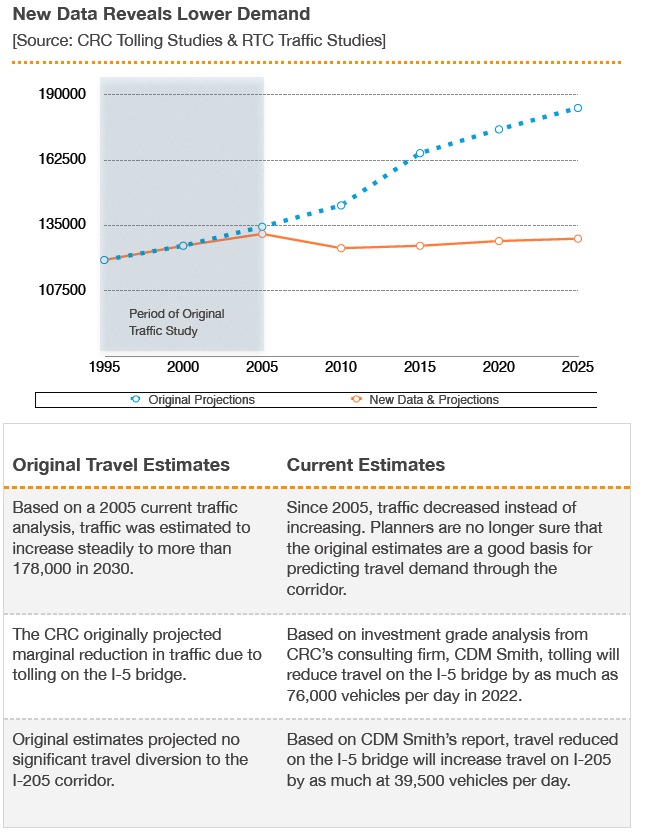1000 FRIENDS OF OREGON
I. Executive Overview
In 2005 Oregon and Washington began a process to identify the key needs for re-designing five miles of freeway and interchanges including the Interstate 5 Bridge, which was built in two phases in 1917 and 1958. In 2013 the Oregon legislature voted to support a bi-state proposal in which the costs, risk, and management experience were shared with Washington state. Later in 2013, the Washington legislature failed to support the project.
Losing this partner raises many questions for the future of the project.
The 2014 legislative assembly will be asked to support a new $2.8 billion plan in which Oregon alone would shoulder full financial, legal, planning, management, and execution responsibilities for the project. Many Oregon leaders saw the original proposal to build a multi-state project as a significant risk. For these leaders and scores of new concerned leaders, this proposal to “go it alone” represents the same initial risks, with increased financial risk and no new or additional benefits for the state of Oregon. Going forward, Oregon taxpayers would take on at least $1.6 billion in additional loan and bond obligations for the new “Oregon Only” plan. This number would increase if costs run over, if toll revenues fall short, or if Federal grants and loans are not fully funded.
After concluding this review of the available data, we urge legislators to vote against the current “Oregon Only” option. It does not meet many of the most important interests of Oregon voters, and it exposes Oregon taxpayers to avoidable financial risk. Alternative proposals and concepts offer meaningful advantages over the current CRC proposal, yet they have not been fully explored by the legislature.
Voting against the “Oregon Only” option does not close the door on a new bridge, or on addressing concerns of safety, freight and commuter mobility, transit options, mixed-use development, and prudent fiscal planning.
Critical Interests
1. High Taxpayer Risk
The new “Oregon Only” proposal introduces new costs and new risks to Oregon tax payers. It is not clear from the CRC’s financial plan that the toll revenue for the project will be sufficient and timely to pay both the amortization of the bond debt for the bridge and also the high costs of operating the bridge tolling system.
The CRC’s financial plan relies on assumptions about three things: (1) ability to contain costs during construction, (2) federal support, and (3) revenue from tolling. The most recent financial statements from ODOT show a plan to spend $2.79 billion on the project, and a plan to raise $2.71 billion, showing an $86 million dollar shortfall. The back-up plan, if costs are higher than anticipated, or if Federal grants, loans, or tolling (or all three) are lower than anticipated, is to increase tolls, reduce or eliminate other transportation projects in the state, and to raise taxes.
2. Travel Demand Lower Than Projected
Estimates of travel demand for both commercial and non-commercial vehicles have changed since the original case was made for this project. Original estimates of travel demand were based on a ten-year period, from 1995-2005, of increasing daily traffic averages on the bridge. Original projections showed average daily traffic increasing to 184,000 vehicles in 2036. That projected level of growth raised concerns about increased congestion, wait times and collisions on and around the I-5 bridge.
However, as has been recently revealed in the state-commissioned Investment Grade Analysis, those traffic projections were incorrect. Travel demand has declined in Oregon and around the nation since 2005, even excluding the effects of the recession. This multi-year national trend is unlikely to reverse.
The original incorrect projections were the basis for the design, financial plan, and environmental impact assessment for the CRC. These new data invalidate the core transportation argument for the project.
Download full version (PDF): CRC Facts
About 1000 Friends of Oregon
www.friends.org
“Working with Oregonians to enhance our quality of life by building livable urban and rural communities, protecting family farms and forests, and conserving natural areas.”
Tags: 1000 Friends of Oregon, Columbia River Crossing, OR, Oregon







 RSS Feed
RSS Feed